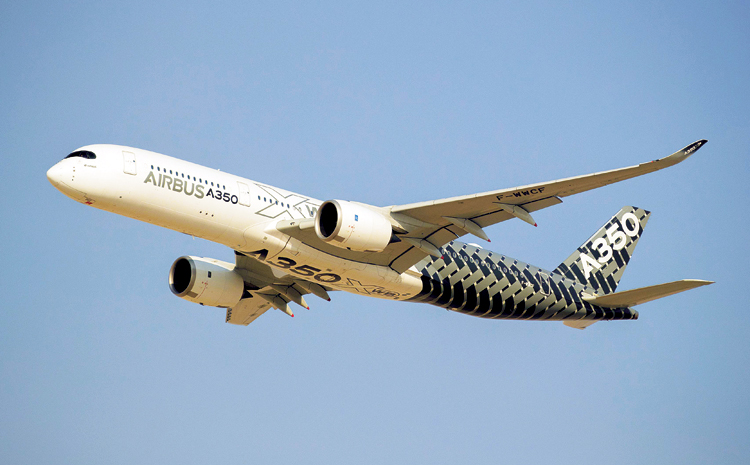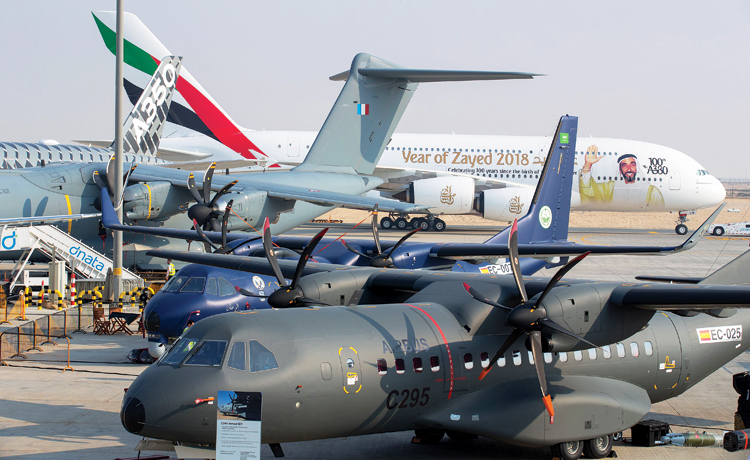INDIAN ARMED FORCES CHIEFS ON
OUR RELENTLESS AND FOCUSED PUBLISHING EFFORTS

SP Guide Publications puts forth a well compiled articulation of issues, pursuits and accomplishments of the Indian Army, over the years

I am confident that SP Guide Publications would continue to inform, inspire and influence.

My compliments to SP Guide Publications for informative and credible reportage on contemporary aerospace issues over the past six decades.
- Prime Minister witnesses 'Bharat Shakti' – a Tri-Services Firing and Manoeuvre Exercise in Pokhran, Rajasthan
- Interim Defence Budget 2024-25 — An Analysis
- Union Defence budget 2024
- Prime Minister Modi Commemorates Indian Navy Day in a Grand Ceremony
- Prime Minister Modi Flies in the LCA Tejas
- New Chapter in India-Italy Defence Ties
- Airpower beyond Boundaries
Big two share spoils, bell tolls for the A380
They left the surly bonds of earth…and touched the face of god.

Aviation’s faithful came to Dubai 2017, its 15th aero exhibition and armed with their cheque books wrote up record deals worth $113.8 billion.
The event, which is held once every two years in Dubai, logged an all-time record high of $206.1 billion in its 13th round held in 2013, whereas the second record high was achieved in 2007 at $155.5 billion, according to data compiled by financial consultants Mubasher.
2017 event marks a 175 per cent surge in the value of deals signed compared to the previous round held in 2015, which saw only $39.8 billion in agreements.
The first two days belonged to Boeing and it looked all but over for Airbus. Even their chalet was relatively silent and gloomy as the American manufacturer reeled in the orders. Emirates, as host carrier, set the pace by ticking the box for 40 Dreamliners and this 787-10 investment worth $15.1 billion will replace the Triple seven fleet as Emirates increases its frequency on the under 10 hour routes. Any misgivings over the ability of the Dreamliner to perform at max levels in the heat of the desert were set aside and the A350 which still has residual affection and a better range and cost per passenger aggregate fell by the wayside.
As Airbus saw no more than the shadow of a smile on opening day there came the double whammy with flydubai, now a registered adjunct of Emirates, picking up a $27-billion deal to purchase 225 Boeing 737 MAX aircraft, with options to buy 50 additional aircraft.
Airbus could by then have packed its bags and skulked off but wait, there was a major trick left in the bag and souring the bubbly at Boeing was on the cards. Hours later even as media and the aviation industry was empathising over the mauling Airbus was getting came the mega announcement. It was the biggest deal in history and Indigo US was making it. Airbus gently and yet with a dash of soigné announced the securing of an order valued at nearly $50 billion for 430 planes from its single-aisle A320neo line. Suddenly the dimmed lights at Airbus went bright and life was good again.

While the agreement added to the lure of Dubai as a leading venue for the bi-annual gathering and gave it a full chapter in modern aviation history it also allowed Airbus to pump up a bottom line hurt badly by the loss of love for the A380.
Actually it really is not a loss of love as much as it is a pragmatism reflected by Airbus having to guarantee Emirates ten year production of the behemoth if there was any chance of getting Emirates to buy more aircraft.
For the moment despite the excitement it was an inhouse celebration for Airbus as it packaged it coloured paper as a gift for sales chief John Leahy days before he flies into retirement. The pair of giants had shared the spoils again. One calls them a pair advisedly because they work it out so they end up with equal shares of the market.
Of course what all this means is that the show is a success, the main stars have their lines right and everyone who is anyone is engaged in an orgy of backslapping one another on a job well done.
Many factors will kick in before the planes materialise in the skies with the livery of those who have gone in for them. As of now, the hard facts are that the bells you hear could well be the death knell for the A380 production line. Airbus has to be sorely wounded by the loss of the A350 option to Emirates when they could have had a solid deal in the bag that would have cold compressed the A380 bruising. But without it, the scuttling of the double decker flagship is twice as hurtful.
The $2 billion needed to extend the wings by 15 feet, improve the range, reduce the per passenger cost effectiveness by 13 per cent and make the aircraft viable to its best customer is blowing in the wind because without other customers the sums do not add up... and there is no one knocking on the door.
The general belief now is that with Emirates hedging its bets and being frontal and transparent in its demands Airbus will return to Toulouse in an ambivalent frame of mind, ready to make the cruel cut…and mothball it’s a 380 line.

The comfort from Indigo’s largesse is still in the MoU stage and not signed and sealed so there can be many changes to what Bill Franke at Indigo Partners finally picks up for his carriers: Frontier Airlines, Volaris, Wizz Air Holdings, and JetSmart, the last now operating out of Chile.
It is a toss up how many of the 273 A320neo jets and 157 of the A321neo variant will finally be picked up and much will depend on the oil prices, the peace in the region, the liquidity in the carriers in the Middle East and how the projected need for 10,000 new aircraft across the size spectrum pans out with the flying public. It has to be remembered that Qatar is already hurting by virtue of political isolation, Etihad has had two rough hits through its investments in Air Berlin and Alitalia and there will also be competition from airlines exercising the fifth freedom to fly between two foreign countries on a flight originating or ending in one’s own country. Add to that the unofficial but widely practiced sixth freedom of flying from a foreign country to another while stopping in one’s own country for non-technical reasons and regional carriers are not going to find it easy. With India, China and the ASEAN belt expected to be the new emerging markets the attention of the industry will engage in a tectonic shift.
In other deals Bombardier signed a letter of intent with Egyptair for the purchase 24 CS300 jets and Watanya Airways took the first step towards a possible 25 A320neo aircraft to Golden Falcon Aviation,its exclusive aircraft supplier.
In a breakdown given by Mubasher the delas per day make for impressive reading. On the first day of the Dubai Airshow, deals signed amounted to AED 71 billion ($19.34 billion), while on the second day, companies signed AED 14 billion ($3.8 billion) in agreements.
The third day saw AED 26 billion ($7.1 billion) in deals, while the fourth marked the highest value of agreements signed with AED 282.5 billion ($77 billion).
The fifth and final day of the Dubai Airshow saw AED 4.5 billion ($1.23 billion) in signed agreements.
Airbus and Boeing came away with orders of 695 planes worth $92 billion of which Indigo helped the French manufacturer pull in 510 aircraft of which 502 were from the A 320neo family and the rest were for the company’s multi-role C295 transports and ‘H generation’ H160 rotorcraft at a tag of $58.3 billion, according to Airbus.
Boeing, however, said it secured total commitments for 302 aircraft — including 50 options — with a value of about $50.7 billion at list prices during the air show. It also signed agreements with Azerbaijan Airlines, Alafco, and Ethiopian Air. Meanwhile Air Arabia signed for the vlease of six Airbus 321neos to augment its fleet.
And as the 160 aircraft in the static display took off for home there was good reason for Dubai to feel satisfied.
Now time will tell if the figures will be infused with a life.





